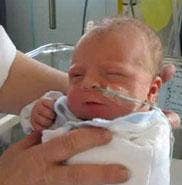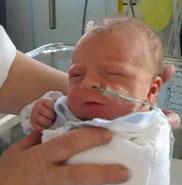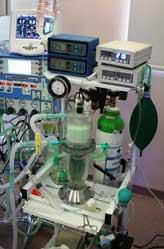Cold Temp and Xenon Gas Save Baby Starved of Oxygen – Are you next?

Share
Riley Joice was one of more than one thousand children in the UK each year who are born oxygen deprived. He had about equal hopes of dying, having permanent brain damage, or surviving unharmed. To boost his chances, doctors at the University of Bristol and Swansea University cooled his body and gave him xenon gas to breathe. Joice was the first baby to ever receive this treatment and he has made a full recovery. At least a dozen more babies will undergo the same approved experimental procedure in the upcoming months. This work not only suggests a new technique for saving such children, it could lead to new treatments in anesthesia and brain protection for everyone.
The benefits of hypothermia on combating oxygen deprivation (and vice versa) have been known for some time. University of Bristol Professor Marianne Thoressen has been studying the protective properties of mild hypothermia on oxygen starved infants since the late 90s, and has been cooling babies since 1998. Infants like Joice are typically cooled to 33.5°C (92.3 °F) for 72 hours. Her results had been positive but not a guarantee against brain damage or death. Something more was needed.
Which is where xenon comes in. The noble gas is chemically inert, with few side effects when used in the body. Dr. John Dingley of Swansea University has been studying the effects of xenon for the past decade. Earlier research has shown that xenon blocks the release of neurotransmitters in the brain and affects NMDA receptors. Different teams have shown that the use of xenon and cooling on rats effectively prevents their brain cells from being damaged by lack of oxygen. Dingley and Thoressen continued this work on rats in 2008 and were enthusiastic in bringing the treatment to human infants. Joice was given three hours of xenon gas mixed with air, seemingly enhancing the beneficial effects of cooling.
Xenon not only acts as a neuroprotector, it's also an anesthetic. It is rarely used in this capacity, however, because it's also very expensive (~£30/liter or $120/100 grams). Part of the success of this treatment was not simply that Joice survived in good health, but that Dingley was able to develop a machine (effectively a xenon rebreather) that allowed for the process to only consume ~200 mL of xenon per hour instead of many liters per hour. This means that adult dosing may be possible at nearly the same low cost.
Be Part of the Future
Sign up to receive top stories about groundbreaking technologies and visionary thinkers from SingularityHub.


Will we want to start using xenon more widely as an anesthetic? Possibly very much so. Neuroprotectors, especially chemically inert ones that exit the system with virtually no side effects, are rare. Other researchers, perhaps building off Dingley's design, are likely to find other applications of this gas.
I'm also very strongly reminded of the work of Mark Roth in the field of suspended animation. As you may recall, Roth has explored how hydrogen sulfide can cause acute oxygen deprivation severe enough to provoke humans into a state of quasi-hibernation that will help keep them alive on the way to a hospital after trauma. Could the neuroprotecting effects of xenon be added to this technique? I think it possible that we may eventually happen upon a cocktail of substances (and perhaps temperatures) that when applied correctly could preserve humans for many hours or even days without any body or brain damage.
For now, Thoressen will continue to chill babies and Dingley will continue to gas them and very likely this will lead to more lives saved and brain damage prevented. We should keep in mind, however, that Joice is only an isolated case at this point. Even with the dozen or so new infants which are likely to be treated in upcoming months we will be far from a proven therapy for all oxygen deprived babies. More research will be needed. Luckily, the Sparks charity has already contributed £800,000 to this project (£1.4 million in total to the group) so the team will have the means to test their treatment for as long as it takes. I hope that this experiment, along with others, will reveal more hidden ways in which we can manipulate the chemistry of the brain to protect it in times of trauma.
[image credits: University of Bristol, Swansea University]
[source: University of Bristol, Swansea University, Dingley et al (2008), Dingley et al (2006), Ma et al (2005), Petzelt et al (2003)]
Related Articles

This Light-Powered AI Chip Is 100x Faster Than a Top Nvidia GPU

Hugging Face Says AI Models With Reasoning Use 30x More Energy on Average

Study: AI Chatbots Choose Friends Just Like Humans Do
What we’re reading

